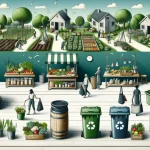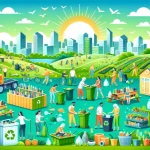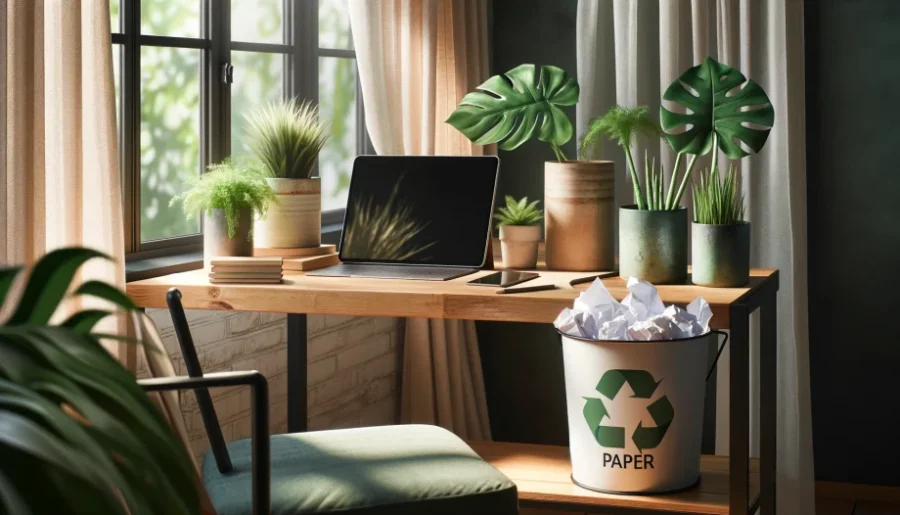 Discover easy, impactful tips on reducing paper waste at home and embrace a greener lifestyle today. Let’s make a difference, one sheet at a time!
Discover easy, impactful tips on reducing paper waste at home and embrace a greener lifestyle today. Let’s make a difference, one sheet at a time!
Reducing Paper Waste at Home
Key Takeaways:
- Reducing Paper Waste at Home involves:
- Embracing digital tools for note-taking and document storage, opting for double-sided printing, and recycling diligently.
- Simple steps like using digital receipts, subscribing to online bills, and repurposing paper for crafts can significantly lower paper consumption and environmental impact.
Ever wondered how to reduce paper waste at home and do your bit for the planet? Well, you’re in the right place!
From going digital to repurposing and recycling, we’ve got all the tips you need to cut down on paper use and live more sustainably.
Join us on this green journey and see how small changes can make a big impact!
Introduction to Reducing Paper Waste
Hey there! Ever think about how much paper we use and throw away every day? It’s a lot, and it’s not great for our planet.
Reducing paper waste is super important for keeping our environment healthy.
It’s all about living in a way that’s good for the Earth. This includes growing plants indoors and finding smart ways to use less paper.
In this blog post, we’re going to share some cool tips and tricks to help you use less paper at home. Let’s make a difference together!
Why Cutting Down on Paper Matters
Save the Trees
Every piece of paper starts with a tree. By using less paper, we save more trees. This is good for the air we breathe and the animals that live in forests.
Less Trash
Using less paper means less trash. This is great because it means less stuff in landfills. It’s a simple way to help the planet.
Save Energy
Making paper uses a lot of energy. When we reduce paper usage, we save energy. This helps fight climate change.
Sustainable Living and Indoor Gardening
Grow Green
Indoor gardening is a fun way to live sustainably. Plants clean the air and make your home look nice.
Reuse Paper
You can use old paper for your plants. It’s a creative way to reduce waste. For example, use paper to make pots for your plants.
Use paper as mulch indoors and out. Old newspapers work great as garden mulch. Just make sure the edges are buried so it doesn’t blow away.
Connect with Nature
Growing plants at home helps you feel connected to nature. It’s a reminder of why we should use less paper.
Our Goal with This Post
Actionable Tips
We want to give you easy tips that you can start using today. Our goal is to help you reduce paper waste easily.
Innovative Solutions
We’ll share some smart ideas that maybe you haven’t thought of before. These will help you cut down on paper in cool ways.
Make a Difference
Together, we can make a big impact. Every little bit helps. Let’s start reducing paper waste at home!
Stay tuned as we dive into these topics. We’re excited to help you live more sustainably and reduce paper waste in your daily life. Let’s get started!
Understanding Paper Waste
Let’s dive deeper into why paper waste is a big deal. You might not think much about that sheet of paper you just tossed, but it adds up.
Paper isn’t just about trees; it’s about the energy, water, and resources used to make it.
And when we throw it away, it piles up in landfills. Here, we’ll look at the impact of paper production and disposal, some eye-opening stats, and how all this paper use is linked to cutting down too many trees.
The Impact on Our Planet
Big Energy, Big Water
Making paper needs a lot of energy and water. This adds to pollution and strains our resources. It’s a big deal for the environment.
Trash Trouble
After we use paper, it often ends up in landfills. Here, it breaks down and can release methane, a powerful greenhouse gas. Not good for climate change.
Chemical Concerns
Paper production uses chemicals that can harm our water and soil. This pollution affects animals, plants, and people too.
How Much Paper Do We Waste?
A Mountain of Paper
In the United States, people throw away millions of tons of paper each year. That’s like a mountain of paper waste!
Office Overload
Did you know the average office worker uses a ton of paper every year? That’s a lot of reports, memos, and notes.
Home Habits
At home, we use paper towels, paper napkins, and junk mail. It all adds up to a big part of our trash.
Trees Tell the Tale
Forests at Risk
For paper, we need trees. Lots of them. Cutting down trees for paper means less forest. This hurts wildlife and the air we breathe.
More Than Just Trees
Forests are more than trees. They’re homes to animals and plants. They also help control the climate. When we use less paper, we help save these important places.
A Chain Reaction
Using too much paper leads to more trees being cut down. This can lead to deforestation.
It’s a big word that means we’re losing our forests. And that’s not good for anyone.
Understanding paper waste is the first step. Now that we know more, we can start making changes.
Small steps at home can lead to big changes for our planet. Let’s keep learning and doing better!
Practical Steps to Reduce Paper Waste at Home
Cutting down on paper waste is easier than you might think. With a few changes and some cool digital tools, you can make a big difference.
Let’s talk about how going digital can help, what apps and online platforms are out there, and some handy tips for making your home office paperless.
It’s all about making small changes that add up to a big impact.
Embrace the Digital Age
Note-Taking Apps
Gone are the days of scribbling notes on paper. Apps like Evernote or Google Keep let you jot down everything digitally.
It’s super easy and you can access your notes from anywhere.
Digital Documents
Storing documents on your computer or in the cloud means you can say goodbye to filing cabinets full of paper and store them in a digital format.
Services like Google Drive or Dropbox keep your important files safe and sound, and you can share them without printing a single page.
Online Bills and Statements
Switch to online billing and bank statements. It’s a simple switch that cuts down a lot of paper use.
Unsubscribe from mailing lists that generate a lot of junk mail.
Plus, it’s easier to keep track of your bills and payments when everything’s in one place online.
Apps and Platforms to the Rescue
Minimizing Paper Use
Many apps and platforms are designed to reduce how much paper we use.
For example, Adobe Sign or DocuSign lets you sign documents electronically. No need to print, sign, or scan.
Sharing Made Simple
Tools like Google Docs or Microsoft OneNote make it easy to collaborate with others without printing.
You can work on documents together in real time, no matter where you are.
Reading Digitally
Instead of buying paper books or magazines, try digital versions.
E-readers and apps like Kindle or Apple Books offer tons of reading material without using any paper.
Tips for a Paperless Home Office
Start Small
Going paperless doesn’t happen overnight. Start with one area, like your bills or note-taking, and expand from there.
Get the Right Tools
Make sure you have what you need, like a good scanner for digitizing documents you already have.
A tablet with a stylus is great for taking notes without paper.
Organize Digitally
Create a system for your digital files just like you would with paper. Use folders and tags to keep everything easy to find.
Communicate Your Choice
Let friends, family, and businesses know you’re going paperless.
They’ll often support your choice by sending you digital documents instead of paper.
By embracing digital tools and making a few changes, you can significantly reduce the amount of paper waste in your home.
It’s good for the environment, and it can make your life easier too. Let’s take these steps together and move towards a more sustainable future.
Smart Printing: When You Really Need to Print
Sometimes, printing is unavoidable. But even then, we can make smarter choices to minimize waste.
Let’s explore how double-sided printing, choosing eco-friendly fonts and paper, and other smart printing practices can help us reduce our paper footprint.
It’s all about making better choices when we have to print.
Double-Sided Printing and Eco-Friendly Choices
Double Your Impact
Double-sided printing is a game-changer. It cuts your paper use in half right off the bat.
Most printers have this option, so it’s an easy switch with a big impact.
Pick the Right Font and Paper
Did you know some fonts use less ink? Fonts like Garamond or Century Gothic are not just stylish; they’re eco-friendly too.
And when you choose recycled paper, you’re giving new life to old materials. It’s a win-win.
Settings Matter
Adjust your printer settings for eco-mode. This uses less ink and is perfect for everyday printing. Remember, less ink means less environmental impact.
Preview and Proofread: Your New Best Friends
Catch Mistakes Early
Use print preview to check your document before printing. It’s a simple step that can save a lot of paper. Catching a mistake on screen is way better than after you’ve printed a pile of paper.
Proofread on Screen
Take the time to proofread on your computer or tablet. It might feel different at first, but it’s a great habit. You’ll catch errors without wasting a single sheet.
Recycling and Reusing in the Print World
Toner and Cartridge Recycling
Used toner cartridges don’t belong in the trash. Many stores and brands offer recycling programs. It’s an easy way to help reduce waste.
Embrace Recycled Paper
When you need to buy paper, look for recycled options. This paper uses less energy and water to produce and helps keep paper out of landfills.
Share and Reuse
Got a document you don’t need anymore? Use the back as scratch paper. Or share it with someone else who can use it. It’s all about getting the most out of every sheet.
Smart printing practices can make a big difference in reducing paper waste.
By making a few simple changes, like using double-sided printing and eco-friendly materials, we can significantly cut down on our environmental impact.
Let’s be mindful of our printing habits and choose the smarter, greener options whenever possible.
Reuse and Repurpose: Giving Paper a Second Life
Who said old paper has to hit the bin? Not us! There are tons of creative ways to give used paper a new purpose.
From jazzing up your indoor garden to crafting and DIY projects, let’s dive into how you can reuse and repurpose paper.
It’s all about seeing the potential in what you already have.
Green Thumbs and Paper Pots
Indoor Gardening with Paper
Old newspapers and junk mail can turn into pots for your plants. It’s a fun project that’s good for your green buddies and the planet.
Plus, these paper pots are biodegradable. When your plants outgrow them, you can plant them pot and all!
Seed Starters
Starting seeds? Make your own seed starter pots out of paper. It’s easy, eco-friendly, and your seeds will love it.
When it’s time, plant them directly in the ground or a larger pot. The paper will break down, and your plants will thrive.
DIY Paper Making: A Simple Guide
Gather Your Supplies
You’ll need used paper, water, a blender, and a screen. That’s it! Old bills, notes, and even paper bags can get a new life.
Blend It Up
Tear the paper into small pieces, soak it in water, and then blend it into a pulp. It’s like making a paper smoothie.
Screen Time
Pour the pulp onto a screen in a thin, even layer. Use a sponge to press out the water. This is where your paper starts to take shape.
Dry and Delight
Let your new paper dry. Once it’s ready, you’ve got homemade paper for notes, art, or whatever you like. It’s recycling at its most creative.
Crafts and DIY Projects

Paper Mache Magic
Remember paper mache? It’s not just for kids. Use old newspapers to create art, decorations, or even functional items like bowls and trays.
Scrapbooking and Collages
Use old letters, tickets, and pages from magazines to create beautiful scrapbooks and collages. It’s a great way to preserve memories and reduce waste.
Origami and Paper Art
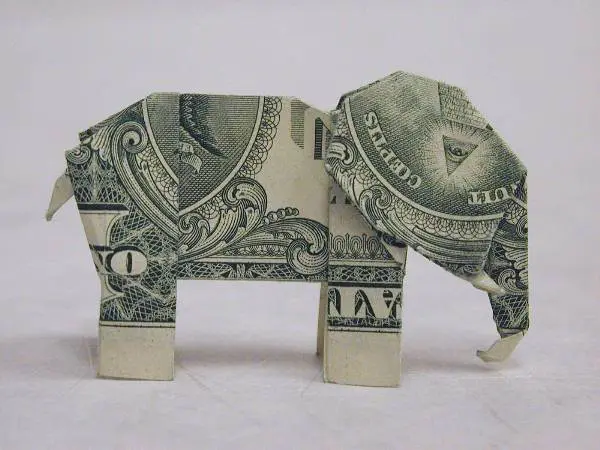
Turn old paper into beautiful origami creations. It’s a relaxing hobby that transforms paper clutter into art. Plus, these make great decorations or gifts.
Reusing and repurposing paper is not just eco-friendly; it’s fun and creative.
Whether you’re into gardening, crafts, or making your own paper, there’s a project for you.
Let’s get creative and give old paper new life. It’s a small step with a big impact on reducing waste and helping our planet.
Sustainable Purchasing Decisions: Shop Smart, Save the Planet
Making smart choices when we shop can have a big impact on reducing paper waste.
It’s not just about what we buy, but how it’s packaged and where it comes from.
By choosing products with less packaging, supporting eco-friendly companies, and picking recycled paper goods, we’re voting for a greener world with our wallets.
Let’s break down how these choices can make a difference.
Choose Less Packaging
Say No to Extra Wrapping
Next time you’re shopping, look for products with minimal packaging.
Do we really need that box inside a box wrapped in plastic? Probably not.
Choosing items with less packaging means less waste to deal with later.
Bring Your Own Bags
Whether it’s to the grocery store or the mall, bringing your own bags cuts down on paper and plastic bags. It’s a simple switch with a big impact. Plus, those reusable bags are way sturdier for your haul.
Support Eco-Friendly Companies
Look for the Labels
Companies that care about forests use labels like FSC (Forest Stewardship Council) or PEFC (Programme for the Endorsement of Forest Certification).
These labels mean the paper comes from responsibly managed forests. By choosing these products, you’re helping protect forests around the world.
Do a Bit of Research
Before you buy, take a minute to look up the company’s environmental policies.
Companies that are serious about sustainability will talk about it. Support the ones that are working to make a difference.
The Perks of Recycled Paper Products
Just as Good, Way Better for the Planet
Recycled paper products have come a long way. They’re high quality and perfect for everything from printing to wrapping gifts.
Choosing recycled means less demand for new paper, which means fewer trees are cut down.
Saves Energy and Water
Making paper from recycled materials uses less energy and water than making it from fresh pulp.
It’s a more efficient process that cuts down on greenhouse gas emissions and conserves precious resources.
Keeps Paper Out of Landfills
Every sheet of paper you recycle can come back as a notebook, a paper towel, or even a cereal box.
It’s a cycle that keeps paper in use and out of landfills. Plus, it reduces the need for new raw materials.
Making sustainable purchasing decisions is a powerful way to reduce paper waste and support a healthier planet.
It’s about being mindful of what we buy and choosing options that are better for the environment.
Every choice counts, and together, we can make a big difference. Let’s shop smart and live sustainably!
Beyond Paper: A Holistic Approach to Sustainable Living
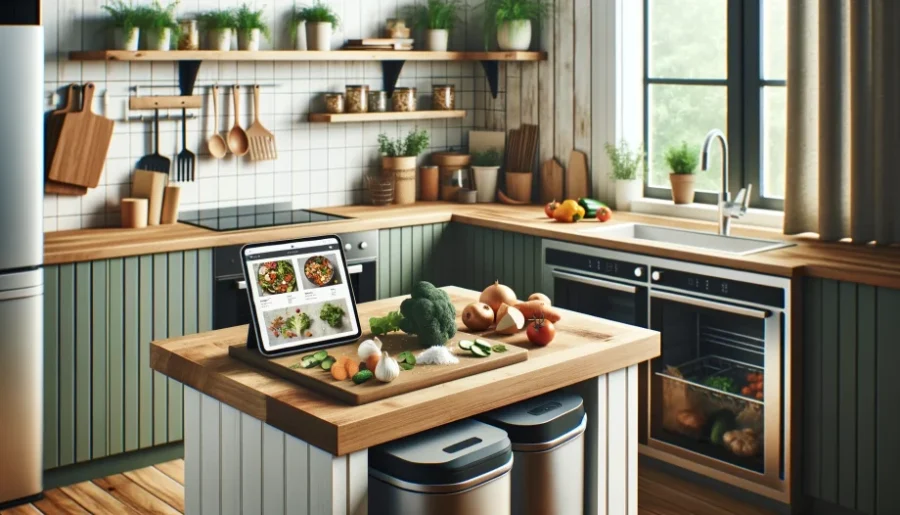
Reducing paper waste is a fantastic start, but it’s just one piece of the puzzle.
Living sustainably means looking at everything we use and do at home.
It’s about cutting down on waste in general, finding new uses for things we might throw away, and getting involved in our communities to make a bigger impact.
Let’s explore how we can take our sustainable living game to the next level.
Cut Down on Waste Everywhere
Think Before You Buy
One of the best ways to reduce waste is to buy less stuff. Before you buy something, ask yourself if you really need it.
Can something you already have do the job? Buying less means less waste, and it saves you money too.
Reuse and Repurpose
Got something you’re thinking of throwing out? Get creative and find a new use for it.
Jars can become storage containers, old clothes can turn into cleaning rags, and furniture can be upcycled with a bit of paint and imagination.
Fix, Don’t Toss
In a world where it’s often cheaper to buy new than to repair, we’ve lost touch with fixing things.
Learning basic repair skills for clothes, electronics, and household items can extend their life and keep them out of landfills.
Composting: Black Gold for Your Garden
Turn Waste into Resource
Composting kitchen scraps and yard waste turns what would be trash into valuable compost.
This black gold is amazing for your indoor and outdoor gardens. It enriches the soil, helps retain moisture, and reduces the need for chemical fertilizers.
Easy to Start, Big Benefits
Starting a compost bin is easier than you might think, and it can be done even in small spaces.
There are plenty of guides online to get you started. Your plants will thank you, and you’ll be amazed at how much less trash you produce.
Did you know that keeping a worm bin in apartments is small, compact, and odorless and worms will eat paper?
Worm castings are like compost on steroids for plants.
Indoor Gardening Boost
For those into indoor gardening, compost can be a game-changer. It’s a natural way to feed your plants and improve the soil.
Plus, it’s incredibly satisfying to see your food waste and scraps turn into something so useful.
Engage with Community Recycling Programs
Beyond the Blue Bin
Recycling doesn’t stop with paper, plastic, and metal. Many communities have programs for electronics, textiles, and hazardous materials. Find out what’s available in your area and take advantage.
Share the Knowledge
One of the best things you can do is spread the word. Talk to your friends, family, and neighbors about recycling and composting. The more people participate, the bigger the impact we can make together.
Volunteer and Participate
Many communities have clean-up days, recycling drives, and other environmental events.
Volunteering is a great way to meet like-minded people, help your community, and make a difference in your local environment.
Living sustainably is about making conscious choices in all areas of our lives.
It’s a journey, not a destination, and every little bit helps.
By reducing our overall consumption, embracing composting, and getting involved in community recycling programs, we can make our homes and our world a better place.
Let’s take these steps together and work towards a more sustainable future.
Wrapping It Up: Our Journey Towards Less Paper Waste
We’ve covered a lot of ground today, from understanding the impact of paper waste to exploring practical steps for reducing it in our daily lives.
We’ve seen how going digital, making smart printing choices, reusing and repurposing paper, and making sustainable purchasing decisions can all play a part in cutting down our paper consumption.
But it doesn’t stop with paper.
Adopting a holistic approach to sustainable living, reducing overall waste, composting, and engaging with community recycling programs are all crucial steps in our journey towards a more sustainable future.
Every Little Bit Counts
Remember, it’s the small, consistent actions that add up to big changes.
You don’t have to overhaul your life overnight. Start with one or two changes, like setting up a recycling bin at home or switching to digital bills and statements.
As these become habits, you can add more sustainable practices into your routine. It’s all about progress, not perfection.
Thank you for joining us on this journey towards reducing paper waste and living more sustainably.
Together, we can make a difference, one sheet of paper at a time. Let’s keep the conversation going and continue to share our successes and challenges.
Here’s to a greener, less wasteful world for all of us.
Call to Action
Let’s Make a Change Together
Now that we’ve armed ourselves with knowledge and strategies for reducing paper waste, it’s time to put those plans into action.
We’re inviting you, our readers, to take a stand with us. Let’s each commit to adopting one new paper-saving habit.
It could be as simple as setting your printer to double-sided printing, opting for digital receipts, or bringing your own bags and containers when shopping.
Every action, no matter how small, contributes to a larger impact on our planet.
Spread the Word
Sustainability is a team effort, and the more people we can get on board, the better.
If you found value in this post, please share it on your social media platforms. Tag friends who are passionate about eco-friendly living, or who could benefit from these tips.
Use hashtags like #ReducePaperWaste and #SustainableLiving to join the wider conversation.
Together, we can amplify our impact and encourage a wave of change towards less paper use and more mindful consumption.
Thank you for being part of this important movement. Let’s continue to support each other, share our journeys, and celebrate our collective efforts towards a more sustainable world.
Mastering Zero-Waste Living: 7 Easy Tips and Tricks
Your action today can lead to a greener tomorrow. Let’s get started!
Resources for Further Learning and Action
To deepen your understanding of sustainable living and paper waste reduction, we’ve compiled a list of authoritative resources.
These sites offer a wealth of information, from detailed guides on recycling to insights into global sustainability efforts.
Whether you’re looking for practical tips or in-depth research, these resources can help you on your journey to a more sustainable lifestyle.
Environmental Protection Agency (EPA)
- EPA’s Reduce, Reuse, Recycle: https://www.epa.gov/recycle
- A comprehensive resource for learning about waste reduction, including tips on reducing paper use and recycling.
United Nations Environment Programme (UNEP)
- UNEP’s Resource Efficiency: https://www.unep.org/explore-topics/resource-efficiency
- Offers insights into global efforts for sustainable resource use and how individuals can contribute to these goals.
- Stanford University’s Recycling: https://sustainable.stanford.edu/
- Provides information on recycling practices, including innovative ways to reduce paper waste, from one of the leading universities in sustainability research.
Forest Stewardship Council (FSC)
- FSC’s Responsible Forest Management: https://www.fsc.org
- Learn about how choosing FSC-certified products can help support responsible forest management and reduce the demand for virgin paper products.
Programme for the Endorsement of Forest Certification (PEFC)
- PEFC’s Sustainability Benchmarks: https://www.pefc.org
- Offers information on how PEFC certification ensures that paper products come from sustainably managed forests.
These resources are a great starting point for anyone looking to make more informed decisions about paper use and sustainable living.
By exploring these sites, you can gain a deeper understanding of the issues at hand and discover new ways to make a positive impact on our planet.





